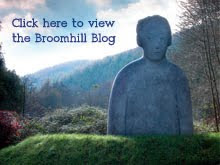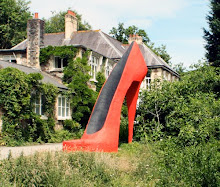The story continues:
Friday
Cast a cylinder of plaster of Paris with a star “hole” through the middle made with wooden pieces with Vaseline on. Carved this immediately into an approximate sphere so that the star points curved around the top and bottom.
This was the fourth maquette carved in plaster and was the most pleasing with potential form for the final sculpture. It was difficult to shape and smooth the interior star shape and the exterior was only roughly shaped with a surform plane by the end of the day. It was enough, however, to point towards a possible solution.
Tuesday
Made a balsa wood maquette similar to the plaster one mentioned above. This time I made a 13 point star to explore the effects of more points. I bought balsa wood sections which are normally used for the trailing edges of model aircraft – these are cut at a10 degree angle. With enough of them glued together I could make a sphere with a hole in the centre and eventually a star shape. This method of construction would mirror that which I would use with a full size sculpture.
I like this maquette and will choose it as the basis for the full size sculpture. At the moment I have in mind a much more spherical shape than the maquette but I do like the irregular lengths of the star points.
Friday
Cut a full size circle out of corrugated card to get an idea of the scale.
Thought the 4 ft diameter looked large enough but this will be expensive on materials. The 3 ft diameter would look ok in the right setting - perhaps among the shrubs and trees. The larger diameter could probably stand out on its own.
Decided to go for a 3.5 ft diameter. Made half size plan drawing and drew up a cutting list. Decided to go for 4 ft height of each plank giving me the possibility of cutting an egg shape rather than a sphere.
Wednesday, 14 April 2010
Friday, 2 April 2010
Essentially my idea was to develop a sculpture for a natural setting such as a garden. There was something about using a public space and not having to exhibit formally in an art gallery that appealed to me. There was a precedent for students placing their stuff temporarily in the College gardens so I negotiated a spot:
I took a long time to decide which form to use for my sculpture for the environment. I wanted it to be related in some way to the vegetation at the chosen site. Eventually I chose a form, which I had been exploring in my previous work and wanted to know more about. The form, which was bulbous and fruit-like contained, inside, a more geometric star shape which mirrored the spiky leaves of the Chusan and Dracaena palms in the garden.
At the time Henry Moore had an exhibition at Kew Gardens and I had managed to visit Grisedale Forest sculpture as well as Yorkshire Sculpture Park so it all came together.
A visit to an exhibition of Henry Moore’s sculptures at Kew Gardens taught me a number important things:
Scale is important to the chosen setting. Moore’s monumental works were needed to compliment the space in the botanic gardens.
His forms, surfaces and colours all have some kind of organic dimension which I thought was important to a garden setting. (A small, mechanistic bronze by Eduardo Paolozzi looked out of place.)
Finally Moore explored his ideas by making as many as 10 maquettes for every full-size sculpture that was realised.
So I returned to College to start sketching and making maquettes.
There would be an image here but the technololgy has beaten me!
Need to work on this. Besides Barbara says this is all boring...........
I took a long time to decide which form to use for my sculpture for the environment. I wanted it to be related in some way to the vegetation at the chosen site. Eventually I chose a form, which I had been exploring in my previous work and wanted to know more about. The form, which was bulbous and fruit-like contained, inside, a more geometric star shape which mirrored the spiky leaves of the Chusan and Dracaena palms in the garden.
At the time Henry Moore had an exhibition at Kew Gardens and I had managed to visit Grisedale Forest sculpture as well as Yorkshire Sculpture Park so it all came together.
A visit to an exhibition of Henry Moore’s sculptures at Kew Gardens taught me a number important things:
Scale is important to the chosen setting. Moore’s monumental works were needed to compliment the space in the botanic gardens.
His forms, surfaces and colours all have some kind of organic dimension which I thought was important to a garden setting. (A small, mechanistic bronze by Eduardo Paolozzi looked out of place.)
Finally Moore explored his ideas by making as many as 10 maquettes for every full-size sculpture that was realised.
So I returned to College to start sketching and making maquettes.
There would be an image here but the technololgy has beaten me!
Need to work on this. Besides Barbara says this is all boring...........
Subscribe to:
Comments (Atom)



